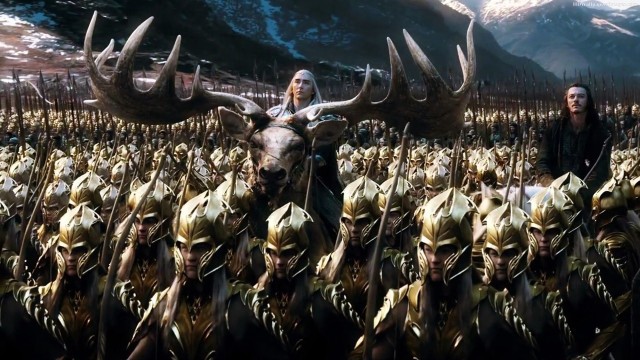
Warner Bros.
…and the giant, flying death-dealer known as Smaug circles above the lakeside town of Laketown, spewing fire and destruction upon its buildings and populace who scramble for safety below. As people struggle to escape, a man named Bard (Luke Evans) strikes back against the dragon. His efforts are ineffectual at first, but the beast’s singular weakness comes into view and Bard fells the monster.
Threat removed, Bard and his fellow humans head up Lonely Mountain to claim their share of the horded gold, but the dwarves – led by Thorin Oakenshield (Richard Armitage) – make a stand saying it all belongs to them. The Elf king, Thranduil (Lee Pace), also arrives with his army in tow, and they’re all soon joined by a legion of dwarves arriving to support Thorin. It’s already a stand-off of Tarantino-esque proportions, but by the time the goblin hordes show up the fight card is filled to the cinematic brim and ready to paint the mountain red.
The Hobbit: The Battle of the Five Armies is the final installment of Peter Jackson’s (arguably unnecessary) trilogy adapting J.R.R. Tolkien’s novel, and while it’s neither the best nor the worst of the three films it brings the story to a satisfying conclusion. Mostly because it is a conclusion, but still.
At 144 minutes this is the shortest of the three Hobbit films – An Unexpected Journey is 169 and The Desolation of Smaug is 161 – and while it’s a frequently energetic and exciting experience it’s also filled with generous portions of filler. That excess starts immediately with Smaug’s demise. It’s a ten minute sequence that belonged at the end of the previous film – you know, the one that refers to Smaug’s desolation right there in the title – but it exists to start things here with a dramatic bang before moving into the setup that fuels the big, final battle.
The heart of the film is a toss-up between two relationships. The friendship between Bilbo (Martin Freeman) and Thorin is effective, and both actors emote beautifully, often in silence and solely with their eyes. There’s also something of a doomed, interspecies romance between the spry elven warrior Tauriel (Evangeline Lilly) and the least dwarven-looking dwarf, Kili (Aidan Turner). Both pairings work well enough due more to the power of the performers than to the time given to their stories.
By contrast, Thorin’s stand-alone drama fails to connect for almost the opposite reason. Jackson gives an abundance of the film over to Thorin’s internal struggle with greed, power and the concept of possession being nine-tenths of the law. He broods and bristles, bristles and broods, and even gets an overlong and somewhat trippy “monologue” of sorts as he faces the consequences of his decisions. Armitage is solid, but the character’s motivation – powerful objects magnify someone’s natural greed! again! – doesn’t justify the time spent.
Still, once the big battles begin the film mostly finds its footing as the various forces clash with deaths on all sides. (Well, all sides except those damn eagles who swoop in again after a day of lazy eagling around.) There are some character bits sprinkled throughout the action sequences – sometimes crammed awkwardly into the mix – but otherwise the third act is a near-constant stream of clashes. Some are suspenseful and stylized including fun bits with Tauriel and Legolas (Orlando Bloom), but much of it is little more than a sea of CGI. Orc-related battles in earlier films maintained character as the evil imps were visible (and severely ugly) creatures, but here the majority of the orc army are armored up, faces included, creating an indistinct mass of metal fighting metal.
The film’s effects are a mixed bag that doesn’t end there as so little of it feels like the “real” world. Too many of the locales feel like they were shot on sound stages or comprised entirely of CGI. Some of the issue may be related to Jackson’s HFR (48FPS) experiment, but even actor close-ups suffer as the fuzzy CG backgrounds behind their heads look relentlessly artificial.
The bigger issue at play here, and the one that’s hardest to forgive, is just how poorly the film works as a stand-alone feature. There’s no emotional build-up, there aren’t enough of the little character moments and the payoff we get is deflated because of it. The elements that work – including a memorable moment between Gandolf (Ian McKellan) and Galadriel (Cate Blanchett) – are spread too thin, but even with the filler the film moves far better than its two predecessors. It’s never dull, and that’s certainly not a claim parts one and two can make.
There will no doubt be an extended edition of the film released a few months after the initial Blu-ray/DVD release, and then we’ll finally be done. The true value of the trilogy will rest in future marathon viewings, but it seems clear even now that The Hobbit films lack the power – visual, visceral and emotional – of Jackson’s Lord of the Rings.
And now we begin the two year wait for Jackson’s adaptation of The Silmarillion…
The Upside: Lots of action; it’s finally over
The Downside: Lots of filler; are we sure it’s over?
On the Side: J.R.R. Tolkien’s The Hobbit is roughly 300 pages long (425 with appendices).
